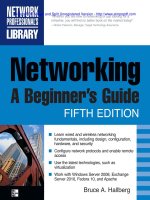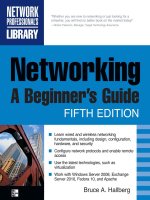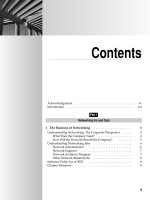Networking: A Beginner’s Guide Fifth Edition- P3 potx
Bạn đang xem bản rút gọn của tài liệu. Xem và tải ngay bản đầy đủ của tài liệu tại đây (105.57 KB, 5 trang )
x
Networking: A Beginner’s Guide
Purchasing the System 191
Installing Servers 192
Maintaining and Troubleshooting Servers 194
Chapter Summary 196
14 Purchasing and Managing Client Computers 197
Choosing Desktop Computers 198
Desktop Platforms 198
Reliability and Serviceability 201
Price and Performance 203
Understanding Network Workstation Requirements 204
Network Workstation Hardware 204
Network Workstation Software 205
Chapter Summary 206
Part II
Hands-on Knowledge
15 Designing a Network 209
The Network Design Process 210
Assessing Network Needs 211
Applications 212
Users 214
Network Services 215
Security and Safety 216
Growth and Capacity Planning 217
Meeting Network Needs 218
Choosing a Network Type 218
Structuring the Network 218
Selecting Servers 220
Chapter Summary 221
16 Installing and Setting Up Windows Server 2008 223
Understanding Windows Server 2008 Editions 224
Preparing for Installation 225
Checking Hardware Compatibility 225
Checking the Hardware Configuration 226
Testing the Server Hardware 227
Surveying the Server Prior to an In-Place Upgrade 228
Making Preinstallation Decisions 228
Wait! Back Up Before Upgrading! 231
xi
Contents
Installing Windows Server 2008 231
Running the Windows Server 2008 Setup Program 231
Performing the Initial Configuration 237
Creating a New Domain 245
Chapter Summary 250
17 Administering Windows Server 2008: The Basics 253
Thinking About Network Security 254
Working with User Accounts 255
Adding a User 256
Modifying a User Account 258
Deleting or Disabling a User Account 262
Working with Active Directory Security Groups 263
Creating Groups 264
Maintaining Group Membership 267
Working with Shares 268
Understanding Share Security 269
Creating Shares 270
Mapping Drives 271
Working with Printers 272
Understanding Network Printing 272
Setting Up a Network Printer 273
Chapter Summary 276
18 Introducing Exchange Server 2010 277
Exchange Server 2010 Features 278
Installing Exchange Server 2010 279
Setting Up Mailboxes 286
Creating a Mailbox 287
Testing Your Mailbox 291
Chapter Summary 294
19 Understanding Other
Windows Server 2008 Services 297
Exploring DHCP 298
Investigating DNS 299
Understanding RRAS 301
Exploring IIS 302
Understanding Windows Terminal Services 304
Chapter Summary 305
xii
Networking: A Beginner’s Guide
20 Installing Linux 307
Configuring Computer Hardware for Linux 308
Hardware Compatibility 308
Server Design 309
Server Uptime 310
Dual-Booting Issues 310
Installing Fedora Linux 311
Choosing an Installation Method 311
Starting the Installation 312
Initially Configuring Fedora Linux 316
Logging in to Fedora Linux 319
And You’re Finished! 320
If It Just Won’t Work Right 320
Chapter Summary 321
21 Introduction to Linux Systems Administration 323
Managing Fedora Linux with Graphical Tools 324
Managing Users 324
Changing Root’s Password 327
Configuring Common Network Settings 328
Mastering Linux Command-Line Basics 331
Working from the Command Line 332
Environment Variables 333
Documentation Tools 335
File Listings, Ownerships, and Permissions 337
File Management and Manipulation 342
Process Manipulation 351
Miscellaneous Tools 355
Chapter Summary 357
22 Setting Up a Linux Web Server with Apache 359
Overview of Apache Web Server 360
Activating Apache Web Server Under Fedora 361
Downloading and Installing Apache Web Server 361
Administering Apache Web Server 363
Stopping and Starting Apache 363
Changing the Apache Configuration 363
Publishing Web Pages 364
Chapter Summary 364
23 Introduction to Virtualization 365
Benefits of Virtualization 366
Introducing Windows Server 2008 Hyper-V 367
xiii
Contents
Using VMware Virtualization Products 367
Downloading and Installing VMware Server 369
Accessing the VMware
Server Management Console 369
Creating a Virtual Machine for Ubuntu Linux 370
Running Ubuntu Linux in the Virtual Machine 384
Installing VMware Tools 386
Backing Up Virtual Machine Data 388
Chapter Summary 388
Appendix Understanding the Sarbanes-Oxley Act 389
Sarbanes-Oxley Act Summary 390
Title I: Public Company Accounting
Oversight Board 390
Title II: Auditor Independence 391
Title III: Corporate Responsibility 391
Title IV: Enhanced Financial Disclosures 393
Titles V, VI, and VII 394
Titles VIII, IX, X, and XI 395
About Internal Controls 395
Key Procedures for an IT Internal Control System 396
IT Department Narrative 396
Disaster Recovery Plan 397
Access Management 398
System Maintenance 399
Change Control 399
SOX Compliance Testing 400
Auditing Internal Controls 400
Deviations from Internal Controls 401
Sample SOPs 401
Disaster Recovery Plan 402
Server Maintenance 405
System Account Management 407
Change Control 411
Index 415
This page intentionally left blank









